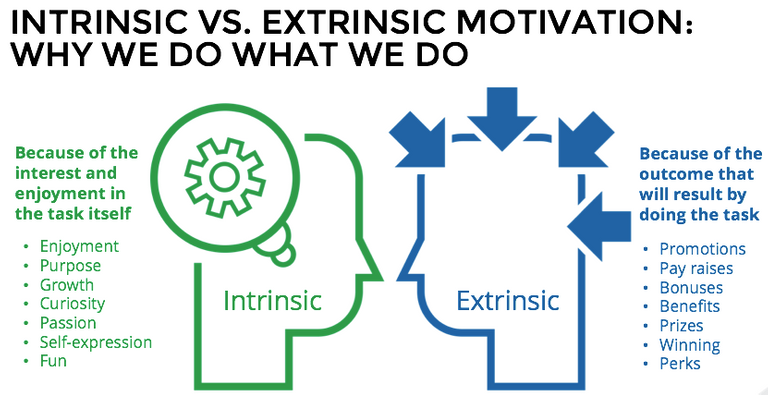
Hello Steemians! This is Jay and you are in the second takeaway of The Confidence Project. How’s your day? I hope it is going well.
Before I start, I would like to thank everyone who supported our initiative, especially the project manifesto and the first takeaway hosted by @thegaillery. We never expected this project to gain a lot of support from the community, which is why we are so grateful. Seeing that the project has a clearer direction of what impact it can do to us, we are more inspired to give to you the best that we can by providing you with tools to aid you in boosting your self-confidence.
Before going to our main agenda, it is worthwhile that we refresh ourselves with the first takeway of The Confidence Project, which talks about determining the area that we want to improve our self-confidence on. You can read Gail’s first post as a way of preparing your thoughts in the next topic on motivation.

I would also like to present my own point of view regarding the first takeaway in order to create fluidity in the new ideas that I will be introducing to you in a while.
Recap of Takeaway #1: Determining Your Areas of Focus
The first takeaway of The Confidence Project highlighted the two aspects of self-confidence: the general self-confidence and specific self-confidence.
I perceive the first aspect of confidence as the typical definition of confident that we often use in our daily language. We sometimes use the word "confident" every time we describe a person who knows how to handle him/herself well in public, who is highly assertive and is engaging well in almost everything that he or she does. We often cannot describe how it happens but confident people certainly emit an unexplainable “vibe” that distinguishes them from others. We see the general self-confidence of a person as a part of his or her overall personality and image.
More often than not, specific self-confidence is something that we do not take notice of as opposed to general self-confidence. It pertains to the confidence that a person develops as he or she performs an ability that is specific to a certain context. Here are some examples that can help you understand what specific self-confidence is. You might realize that all throughout your life, you have been doing a lot of things that aimed at improving your specific self-confidence in a certain area.
• Our Math teacher is amazing because she can solve mathematical problems in just five minutes!
The teacher is able to develop her specific self-confidence in interpreting problems into mathematical equations easily and quickly. This is because she has been teaching the subject for almost 4 years. She also improves her skill by trying out new problems from different textbooks before starting her classes.
• My cousin is a professor with a PhD in Pharmaceutical Engineering. She has already published 5 research articles and is working in a pharmaceutical company as a consultant in the company’s projects related to new drug formulations.
She has spent a huge chunk of her time in studying about Pharmaceutical Engineering for several years and was able to develop her expertise in that field.
• My mother is the best cook for me!
His mother’s role in the family is to provide healthy and delicious food. His mother does her best everyday to learn new recipes and try them out as often as she can until cooking these dishes just becomes a second nature to her.
In what way are the two aspects of confidence related?
The process of building a person’s specific self-confidence in one or more areas can, in the long run, allow him or her to develop the general self-confidence that he or she displays as a part of his or her personality.
This means that in achieving the confident self that we aspire to become, we can focus first on the small aspects of our skills and abilities that we want to be good at. It is certain that once we gain enough experience and can display evident proofs of our capabilities, we definitely gain confidence in that area that we chose to focus on.
This is an essential point that each of us must realize. Confidence is not a privilege that only a few can achieve. Instead, it is a state that everyone can reach through a step-by-step process. As long as we are aware of the things that we want to be good at and spend enough time to it, then it can be a stable foundation to achieve the confidence that will soon define us as a person.
Confidence and Motivation
Let’s say you have chosen a certain ability or skill that you want to be good at. To further actualize your goal of becoming confident in that aspect, you listed three or more things that you will do and you promised yourself that you will do it as often as you can. You felt good about yourself because you thought that was already the start of the transformation that you want to happen. A few days passed and you felt fulfilled as you get to do what you have planned and saw some improvements in your abilities.
However, an emergency happened. Unfortunately, it ruined your schedule and you weren’t able to follow your plans. You forgave yourself at first. The next day you felt tired and forgot to continue working on that task that you planned to do. Days turned into weeks, and weeks turned into months but still no progress was ever done. You decided postpone it and come back to it once you are “ready”. You’re afraid to be honest to yourself about it, but you truly felt bad for not being able to continue your plans of focusing on the area that you want to improve.
Is this story familiar to you, guys? Is it relatable?
Well, don’t worry. It happens to most of us. To be honest, I have been through a lot of episodes of being inspired to start something and then after a while the will to do it just loses. Before, I even tried to fool myself by saying “maybe it’s not the right time”. Right now, I am happy to say that the poor mindset of believing in the “right time” was a distant memory of my past.
So, what really is the problem? What part of us should we fix?
By careful assessment of my failed attempts to develop my area of focus, I realized that I lack the motivation to continue what I started. I was not able to come into terms with my motivation in the things that I want to do. In other words, I was not clear about the reasons why I want to attain specific self-confidence in a certain aspect.
Every time we want to do something, there is always an underlying reason or driving force as to why we do it. This drive is what we call our motivation. This is related to inspiration, which is associated to an increased appetite in accomplishing a task because of a strong emotion felt by the person doing it. You call yourself a motivated person if you are excited to do something and you have enough stamina to finish it, no matter what obstacles you go through. On one hand, you find yourself unmotivated to finish a specific work if you feel generally uninspired to continue working on a task and lack the right attitude to finish it.
Why is motivation important in this project?
There is a strong relationship between motivation and consistency. The more motivated we are in accomplishing something, the more consistent we are in performing the tasks necessary to achieve that goal.
Motivation is also connected to volition, which is the power of a person to control his or her will in accomplishing something. If a person has a well-defined motivation to pursue his or her goal, he or she is in full control of his or her decisions and is able to develop a strong sense of discipline in finishing what he or she promised to accomplish.
In view of confidence, our consistency and volition at one thing will only be successful if our motivations are well-defined and well-thought-out. Without it, our determined area of focus will only be a promise that we do to ourselves that will sooner or later be broken.
Extrinsic vs. Intrinsic Motivation
It is a fact that people vary in the degree and orientation of their motivations. While it is difficult to generalize some ideas regarding the degree of a person’s motivation because it is solely dependent on a unique mental framework of an individual, we can easily determine where a certain motivation is coming from (hence the term orientation). We can classify the orientation of our motivations into two: intrinsic and extrinsic.

Summary of the Differences Between Intrinsic and Extrinsic Motivation (Image Source)
Intrinsic motivation pertains to the willingness of a person in doing something because that person has an innate interest in the nature of the activity that he or she is doing. Our natural inclination to our hobbies and interests is shaped by the environment that we are in and by how we are raised up from childhood until now. The main characteristic of intrinsic motivation is a person’s positive emotion towards a task. When we are intrinsically motivated, we are considering the feeling of comfort and fulfillment while doing it. This type of motivation is tied to our values and character as an individual. This aspect is closely linked to our inspiration.
I want to share one inherent interest of mine as an example. Ever since I was 12 years old, I already have this strong interest in learning different kinds of languages. I want to become a polyglot. Because of this intrinsic motivation to learn, I started to buy books about the Japanese language at that age. It was followed by Mandarin Chinese, then Korean, Brazilian Portuguese, and then French. I’m definitely not fluent in these languages, to be honest. Even though it is really difficult, I really enjoy the feeling of spending my time following the accents of each of these languages and mimicking the strokes of the characters that comprise their writing systems.

Some of my language materials. I made a notebook for each language that I am interested in to take note of my progress.
Extrinsic motivation, on one hand, pertains to the willingness of a person in doing something because a person is anticipating an outcome in a form of either a tangible or intangible thing. When we are extrinsically motivated, we have the appetite to accomplish a goal because we want to get rewards in a form of a prize, or we want to get the positive response and recognition from another person. People are also extrinsically motivated because they want to stay away from a negative consequence. Here are some examples:
• Gina was diagnosed with a high risk of acquiring type 1 diabetes, so she decided to curb her diet by lessening the amount of sweet food and drinks that she eats.
• Jay is amazed by the monetary rewards that he can get from blogging here in Steemit, so he really works hard to produce quality content.
• Alfred studied all weekend and sacrificed his free time in order to master the topics for his exam on Monday. He is aiming to get a perfect score in this exam because he wants to achieve the Summa Cum Laude honors.
Again, the main focus of extrinsic motivation is the outcome of the task. Unlike intrinsic motivation, this form of motivation does not consider the positive emotion or feeling while doing the task. Let’s take for example the first case: Gina loves sweets but she needs to stop eating it in order for her to stay healthy. Even though it is against her will, she needs to do it for her own good.
The Balance Between the Two Orientations of Motivation
A lot of researches have been done on motivation, as it is a critical element in a person’s success in his or her identity, career and life choices. The basic question that one can make about the two orientations of motivation is: Which of the two is better?
Some of you might think that intrinsic motivation is the better one since it is naturally coming from the person’s inherent interests. Some studies have also reported that people who are intrinsically motivated have the propensity to stick to the task, spend more time in the task and become successful at it.
However, there is danger in relying too much in our intrinsic motivation. Not all of our goals are strongly connected to our inherent interests. If we are solely focused in our intrinsic motivation, we find it hard to accomplish these goals because it so happen that the process of attaining these goals involves emotional discomfort on our end. We might not want to pursue it because we do not feel comfortable and fulfilled while performing the task.
On the other end of the spectrum, relying too much in extrinsic motivation does not do good in the development of our behavior as a person. People experience what is called the overjustification effect every time they do something just because they only expect the rewards in the end. Without the rewards, they do not do their best in their tasks. Clinging solely on the outcomes makes a person lose his or her sense of fulfillment and meaning.
This leads us to the conclusion that both orientations of motivation are essential. It is natural for humans to be enticed with rewards, which means that extrinsic motivators are beneficial in pushing us to our limits and propels us to maintain the right attitude while doing the task. To balance the strain and pressure brought upon by extrinsic motivators, intrinsic motivators must be present. These assure us that the journey to accomplishing the challenge and achieving success is fulfilling in the end. Intrinsic motivators help us in sustaining the transformation that we go through and aid us in realizing that there is still fun behind every challenge encountered.
Wrapping Up the Main Ideas of the Takeaway
To make sure that this takeaway is doing its purpose, I decided on declaring these important points. If there are ideas that you might forget about this topic, just be sure that these three points are not those:
• Being confident as a person starts with being confident at certain aspects. As you choose an area of focus, your goal is to establish your specific self-confidence. As you develop more areas in your life, you are eventually developing your general self-confidence.
• Establishing a confidence in a specific aspect requires a long process, and in order to ensure consistency and volition in the things that you do to be confident in that area, you need to have a clear and solid motivation.
• Intrinsic and extrinsic motivation are both relevant in establishing specific self-confidence. There must be a balance between the two and that they should work hand-in-hand.
Challenge
So yes, we are done with the second takeaway! Are you ready for the challenge?
Here it is:
1. Determine your areas of focus as discussed in Takeaway 1. You don't need to make a separate entry for it, you just have to determine these areas that you would like to focus on so that you can establish your motivation accordingly.
2. Clearly lay out your motivations behind the area/s of focus that you chose by classifying them as intrinsic and extrinsic. For each motivation that you have declared, explain the reasons why you think this can propel and sustain you from becoming successful in doing the things that you want to focus on.
3. To help you in constructing the details of your entry, here is an example. As you can see, the presentation is a brief one. You are free to express your ideas without being conscious about the length of your explanation.
Area of Focus: Develop confidence in writing
Activities to Build an Accurate View of Skills:
• Writing in my journal everyday
• Creating posts in my blog at least once every week
• Read at least one book every month in order to gain a new perspective in different styles of writing
Motivations in Pursuing this Goal:
Intrinsic Motivations:
• I consider writing as a form of reflection. Every time I transform my feelings and ideas into words that I can understand, I get to recognize what these actually are. I consider this important because the more I get to be aware of my thoughts and emotions, the more I gain the wisdom that I need to succeed.
Extrinsic Motivations:
• I want to earn through this writing. Through Steemit, I can monetize every blog post I make and attend to my financial needs.
Follow these steps and post your entries in your respective blogs:
1. Set the title to The Confidence Project Entry 2: Establish Your Motivation
2. Present your entry for this takeaway
3. The main tag of this post should be #confidenceproject
4. Paste the link of your entries in the comments section so we can easily find you
5. Resteem this post to let others know about this challenge too
You can post your entries until March 17, 2017 and the winners will be announced in another post that I will be posting on March 23. The winner/s will be receiving SBD rewards that this post will be getting.
Good luck to you guys! I hope you are interested to join. Steem on!
References
Benabou, R. & Tirole, J. (2001). Self-Confidence and Personal Motivation.
Burton, K. & Platts, B. (2006). Building Confidence for Dummies. John Wiley & Sons, Ltd. Chichester, West Sussex.
Lai, E. R. (2011). Motivation: A Literature Review. Research Report from Pearson.
Reinholt, M. (2000). Towards a More Nuanced Perspective on Motivation in Organizations. Center for Strategic Management and Globalization.
Ryan, R. M. & Deci, E. L. (2000). Intrinsic and Extrinsic Motivations: Classic Definitions and New Directions. Contemporary Educational Psychology. Volume 25, Issue 1, pp. 54-67
My entry confidence project
Hi @jsmalila! I would like to join the project, do I need to write a separate entry for the 1st takeaway or will I just fuse both the 1st and 2nd takeaway in one entry? <3
Hello @reewritesthings! I'm so excited for your entry! <3 Just fuse both the first and second takeaways in one entry. Thank u so much for joining the challenge of the second takeaway!
Here's my entry..😀